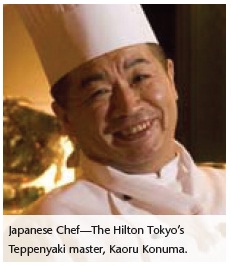Weekender profiles five top chefs making their mark in Tokyo
by Marie Teather
Tokyo has literally tens of thousands of restaurants. In a city with an overwhelming choice of food, it would be good to know how industry figureheads interpret the cuisines here. At various stages of their culinary careers and from all corners of the globe, Weekender spoke to five established Tokyo chefs, to find out just what they think of the Tokyo dining scene and current global dining trends.
Younger generation Japanese chefs are said to be looking west for culinary inspirations, but for 53-year-old Kaoru Konuma, who has 27 years of culinary mastery under his belt, the dedication to his native cuisine remains undeterred. Now reigning at the Hilton Tokyo’s Teppan Grill, and cooking before a very international clientele, he remains proud to educate his guests on the fundamentals of Japanese food preparation. ‘I believe that Japanese food is the best in the world… the delicate presentation representing seasons cannot be seen in other cuisine.’
Since the late 1970s, Tokyo has undergone countless transformations and Konuma has served for Tokyo diners through economic ups and downs, adapting his dishes for cultural shifts. The price of the Teppan course he serves today is almost the same as it was 27 years ago, meaning that teppenyaki is no longer exclusive to selected people, but for everyone. A recent influx of western chefs to Japan and the popularity of Japanese food worldwide has started to cast it’s influence on traditional Japanese menus. ‘Californian Rolls’ or ‘Hawaiian Rolls’ are a good example of ingredients adapted overseas but now ironically finding a place back home in Japan on more traditional sushi counters. Teppenyaki also became popular in foreign countries but is prepared in an elaborate, showy performance—a style not found here in Japan. Of this, Konuma reserves mixed feelings and believes western interpretations to be somewhat lacking, ‘I think it is wonderful that Japanese cuisine attracts attention internationally but it is only a partial imitation. For instance, we use flowers, leaves or specific ingredients in accordance with the seasons, for a very specific reason. Sometimes it represents seasonal, religious purposes or celebration. It would be great if western chefs learnt not only Japanese cuisine, but also the culture behind it.’
Since the 1980s Konuma has been invited as guest chef to kitchens across the globe. Working overseas gives him the opportunity to visit local markets and provides new discoveries in the usage and combination of ingredients. Still, he refuses to change his cooking style even when abroad and always travels with his basic seasonings; miso and soy sauce.
For a man so proud of his native cuisine, would it be too easy to ask him how Tokyo compares to the other international cities in which he has worked? Konuma tells me that like other cities globally you can find whatever cuisine you want here ‘From Turkish take-out Shuwarma, to Michelin 3 star restaurants, from ¥300 self-service curry to ¥10,000 curry served in hotel restaurants.’ Working in Tokyo is for Konuma no doubt the best place to be in the world, although he is careful to add that, being a big city, it can sometimes offer too many choices and that ‘showing clear character is the only way to survive.’
But what for the future of Teppan cuisine and Japanese food? He predicts the preference of Teppan sauce to change as ‘when I started my career, mustard and soy sauce were popular but now wasabi and soy sauce are the trend’. Japanese food, he says, will not change aside from the obvious religious or seasonal meanings becoming weaker. But, with chefs like Konuma still around to keep these traditions around, maybe we shouldn’t worry about this just yet.
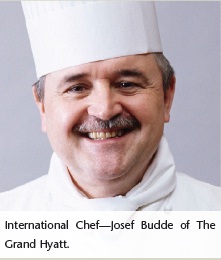
Josef Budde does not stay around in one place for long. Fittingly, after a morning spent looking at beef in Osaka, he was on route back to Roppongi’s Grand Hyatt when I spoke to this busy and most international of Tokyo’s chefs. ‘The great thing about Japan is that I’ve had a chance to go looking for so many new products here,’ he told me, and despite being stuck in traffic, for a man who has worked in kitchens the globe over, his enthusiasm for discovering Japan’s raw produce was unmistakable.
57-year-old Budde accepted his fourth Executive Chef posting for the Grand Hyatt empire in Tokyo, after holding the position in countries across Asia since 1983. He was there for the opening of the Grand Hyatt Tokyo five years ago in a move that was reported his last in a lifetime career that spans 40 years.
‘All of the Hyatt’s menus are based on ingredients,’ he told me. Seeking out the fineness of ingredients that are to be found in local markets is an imperative, and particularly in Japan where the ‘clientele is very demanding in quality—especially down to cigars and wines. ‘For Budde, who also describes himself as a ‘real market man,’ certainly this a personal perk of the job. ‘Being in Japan you can get the best of everything. Sapporo Pork is brilliant. My colleagues often take meat back home as they didn’t realize the beauty of the quality here.’
After working in Germany, England, France, India, US, Singapore, Bangkok and Hong Kong, Budde is no stranger to adapting his cooking styles to suit local palates, and yet in Tokyo, the preferences for less salt and spices has posed him fresh challenges. ‘There is no information book on how to adapt or what to do for diners here in Japan—you just have to be here to learn.’
He credits restaurants in Tokyo as comparable to France and Italy in terms of quality and a clientele that take food very seriously. Furthermore the passion of younger generation chefs astounds him and he believes that established chefs abroad could learn from seeing the training Japanese chefs undertake, or simply the way they take care of their knives. ‘Pastry chefs are displaying quality of the very highest level’ although interestingly he recently asked a group of graduate chefs in which type of food they hope to specialize; the majority oped to work in western kitchens and the least in Chinese or Japanese.
Of foods that are popular in Japan in contrast to the rest of the world, Budde tells me that ‘the ladies here love desserts. They definitely have a sweet tooth. Pretty much everyone has dessert here.’ Budde’s final venture here in Tokyo may well be the icing on the cake of a very global career.
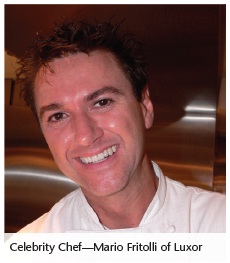
Celebrity appearances on countless Japanese television programs, a presenter of his own weekly television show on MTV, featured in many Japanese magazines each and every month, a model, and author of two books with one more in the pipeline, one would be forgiven for thinking we were talking about a celebrity and not the incredibly talented chef, Mario Fritolli.
Mario has spent the past 30 years across the globe, twenty of which have been in Japan, mastering his passion for cooking. Fritolli innocently exclaims, “I don’t know if I am famous and I don’t care, I do my thing for television and magazines because they ask me to and I enjoy doing it.” He adds, “I didn’t make myself a celebrity, other people made me that. Me is me, Mario is Mario.”
Fritolli’s vivacious personality and enthusiasm is not only infectious, it is prevalent in his ever-changing seasonal menu and in the atmosphere in his stylish, yet relaxed, restaurant in Shirokane. During the five-year tenure at his eatery, Luxor, Fritolli proudly states that he has never repeated the same dish on a new menu, which he creates along with the help of his incredibly friendly staff. “It is important for me that my staff taste each and every dish so that they can explain, both genuinely and sincerely, the taste of each dish to our customers.” He is quick to add that “top class ingredients and originality on presentation and recipe are key—there too many Italian restaurants in Tokyo for it not to be”.
When quizzed on which celebrities visit the restaurant, Fritolli provided me with an impressive list of both international and Japanese stars, but swore me to secrecy on the details, protesting that “I can’t tell you it isn’t fair on them.” Matter-of-factly stating, “That’s the business”.
As he spoke animatedly of the current projects he is pursuing, I wondered how he could possibly manage to fit everything into his schedule and still play husband and father to his celebrity model wife and daughter. My thoughts were disturbed as across the balcony over on Platinum Dori a car comes to a stop and honks the horn. With a pearly white smile Mario cries “ciao” and sends the driver a big wave—he has me charmed. That’s what I love about Luxor—despite the frills and Fritolli’s celebrity lifestyle, you are always made to feel welcome whoever you are, on the one condition that you come to enjoy fine Italian fare!
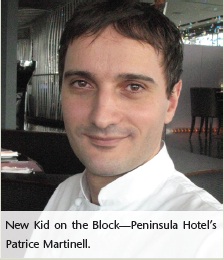
The menu, which Patrice Martinell has been busy creating since his arrival in Japan, debuted before diners just a little over a month ago. Martinell himself arrived only two months earlier and so his first Japanese summer was spent ardently preparing for The Peninsula Tokyo’s grand opening on Sept. 1.
“I spent two months here looking for products, watching the building being built and twisting the menu around to match the restaurant.” The restaurant, named Peter, occupies the whole of the Peninsula’s topmost floor and has a 360-degree view of Tokyo. Inspired by a very modern interior and local produce is Martinell’s resulting fusion of worldwide favorites, incorporated with simply prepared Japanese ingredients.
Looking for produce in July that would be at their best in fall, could have posed a challenge in an unfamiliar country, but Martinell is happy to have found the Japanese as passionate in his creations, as he was to rely on local advice. “The Japanese are very interested in food, not just Japanese food but international food too, and are always asking how you make it and why.”
After working the famed Savoy kitchen in London and Daniel in New York, Martinell’s recent move to Japan appears to be an all thumbs-up, problematic free venture—even some of the twenty chefs that work under him can speak French. As long as the Tsukiji fish that he recently ‘fell in love with’ stays as fresh as his enthusiasm for all things Japan, long may his energy continue.
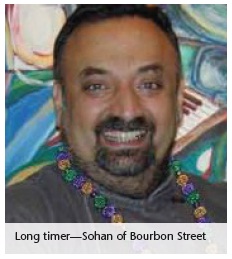
Only those personally acquainted with Chef Sohan are likely to have eaten at his intimate Roppongi eatery. His well-regarded restaurant boasts just five soughtafter tables, meaning reservations in advance a must, and has been serving top-class Cajun and Creole dishes to those-in-the-know since 1999. In a country where food is based on trends, Sohan describes his eatery as serving ‘nontrendy food in a non-trendy restaurant’ but yet with Bourbon Street remaining a long time favorite on the expat scene, and the Chef Sohan himself a popular character amongst those who matter, one does have to question the validity of his voguish definitions.
Coming from an ‘old school’ philosophy on eating out, Sohan explains that he goes to restaurants to marvel at the chef in question. Unlike today’s prevalence for simple easy-for-all preparations and tendencies to concern more about origins of ingredients, he expects great things from his food. ‘Everyone these days is talking about where the ingredients are from and chefs then have the audacity to say, “this is so good it doesn’t need anything.” These days you need a world atlas to eat out but who can really tell where an eggplant is from?’
Ten years ago, he noticed that although having an abundance of personalized Japanese hideaways, Tokyo was lacking in specialist western restaurants—the type where chefs would display master connoisseurship. Wanting to make a place to take family and friends that would be small, intimate and not advertised, Bourbon Street was born and even now almost every client comes through referrals. The menu was inspired from New Orleans, a place as equally revered by the American heart as Kyoto is to the Japanese, and the restaurant came to offer family, comfort food—the very type of place that didn’t exist at the time. What’s more, staying true to the authenticity of Louisiana cooking, the menu has not been adapted to more delicate-loving Japanese palates and defiantly serves up strongly flavored offerings.
In his 25 years of cooking experience here in Japan, Sohan has watched dining fashions come and go. Fusion cuisine caught on globally about 14 years ago and about five years later in Japan. He originally thought allowing chefs to prepare food beyond their culinary boundaries was a great thing but now however, as every menu looks predictably like another, Sohan hopes for a turn-around from seniors in industry and a return back to days of distinct cuisines, ‘Go to a French restaurant for French foods, an Italian for Italian!’
Trendy or not, Bourbon Street is certainly cool; the hushed diners who have been returning for 10 years are testament to that, and as long as Sohan’s passion for food and blues music continues to go against the tide of culinary trends, it may long stay ahead of the game—and surely that is the ultimate in being fashionable.

